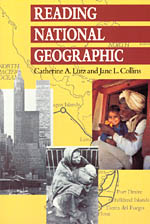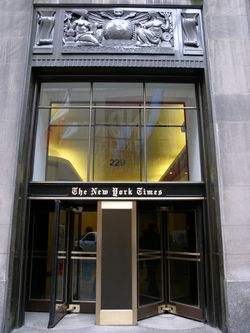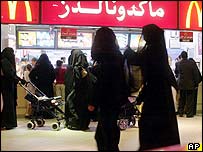The
New York Times and 'The Other'
When conservatives
claim that there is a liberal
media bias
in the United States, they are probably correct. On social issues,
daily print
media in this country, especially the four major national dailies, the New
York Times, the Washington
Post, the Los Angeles
Times, and the Boston
Globe, are by-and-large socially
liberal. By socially
liberal, I mean pro-choice, racially sensitive, feminist-friendly,
gay-friendly, and secular. Of course, TV media and weekly print media
are an
entirely different thing; for reasons that others know better, TV (the
networks, CNN, Fox) and weekly print media (Time, Newsweek)
are predominantly socially conservative. And, of course, Fox is more
fascist
than conservative.
The academic community
largely adheres to these
liberal
beliefs. Having passed through many humanities departments in many
institutions
of higher education, I can attest to the fact that only rarely have I
ever met
anyone who is not pro-choice, racially sensitive, feminist-friendly,
gay-friendly, and secular. Academics spend a lot of time being
understanding of
the "other." You would think that this would be a good thing, and yes,
of
course it is. I strongly support all of these values.
But there is
also something cloying and annoying about this
behavior. This is because all of these media, including National Public
Radio,
while being socially liberal are all generally politically conservative.  This is what denudes
liberalism in
America of all of its power, defangs it, and makes it worthless and
whiny. And
nowhere is this more starkly on display than in the New York
Times. Liberals all over the
country read the Times
as a signifier of
intellectual
status, on Sunday mornings over their coffees or on-line at their
computers,
feeling good about its socially liberal stance.
This is what denudes
liberalism in
America of all of its power, defangs it, and makes it worthless and
whiny. And
nowhere is this more starkly on display than in the New York
Times. Liberals all over the
country read the Times
as a signifier of
intellectual
status, on Sunday mornings over their coffees or on-line at their
computers,
feeling good about its socially liberal stance.
It satisfies
every basic requirement of the modern liberal position: on
social issues, the paper serves as a mirror for your own biases and
preferences, confirming those things that have a moral standing in your
world view, censuring those that are uncivilized. And on foreign
issues, you learn about the world through a prism of benevolent
condescension. A few years ago, Catherine Lutz and Jane Collins wrote a
book, Reading National Geographic
about the ways that magazine has represented "the other" through the
decades to an inquisitive and predominantly liberal American audience.
The writers:
assess how the cultural narratives of
the magazine are
received
peoples and their ways and the wish to validate middle-class American
values. . . . in promoting a kind of conservative humanism that acknowledges
universal values and celebrates diversity while it allows readers to relegate
non-Western peoples to an earlier stage of progress. We see the magazine
and the Society as a key middlebrow arbiter of taste, wealth, and power in
America, and we get a telling glimpse into middle-class American culture
and all the wishes, assumptions, and fears it brings to bear on our armchair
explorations of the world.
You could easily substitute the New York Times for National Geographic. Normally, I wouldn't expect a newspaper to be sensitive about notions of language and power but liberals expect and see the Times as much more than simply a newspaper. It is a window into the world for many educated people in this country. It is considered an informed forum, not one prone to shy away from complexities. And I guess that that's the supreme achievement of the New York Times -- wrapping dumbed down observations about the rest of the world in the false sheen of erudite sophistication.
You can pick up the paper on any given day and there will be some nice piece on some country "far away," an evaluation of that culture through the prism of modern socially conscious liberalism.
 We
can feel good about
expanding our knowledge base about "the other" (where else would you
read about Gabon?). We neatly divide "the other" into two camps, the
"reformers" (a synonym for those who engage in the rhetoric of modern
Western liberalism) and the "radicals" or "orthodox" who cling to
"regressive" (i.e., non-Western) notions of governance and civil
society.
We feel a pang of sympathy for the former ("these women want to be
drive too!"), and refrain from criticizing the latter (because good
liberals don't criticize, they merely explain things), generally
feeling good once again (we learned but we didn't criticize!), and thus
affirmed our universal values of celebrating diversity.
We
can feel good about
expanding our knowledge base about "the other" (where else would you
read about Gabon?). We neatly divide "the other" into two camps, the
"reformers" (a synonym for those who engage in the rhetoric of modern
Western liberalism) and the "radicals" or "orthodox" who cling to
"regressive" (i.e., non-Western) notions of governance and civil
society.
We feel a pang of sympathy for the former ("these women want to be
drive too!"), and refrain from criticizing the latter (because good
liberals don't criticize, they merely explain things), generally
feeling good once again (we learned but we didn't criticize!), and thus
affirmed our universal values of celebrating diversity.
One ubiquitous rhetorical device is the
oft-repeated story about the "Muslim woman." In the New York Times, there's never any
question that Islam explains everything
that happens
to women in Muslim countries. (A
point actually made much earlier by Sarah Graham-Brown in a book in the
late 1980s). For them, there's no other way to understand or locate
these women.
And so, wherever you live, whatever you do, if you have been defined as
being a Muslim woman (often defined for you by others, of course), your
entire existence is defined as
one for or against some abstract
notion of "Islam." Thus, occasionally, the New York Times will print some
fiery interview with some woman in California or somewhere who is
(gasp) critical of Islam.  Islam sucks! Screw that crap! On
the other
hand, it will print a story about women in some generic Arab country
who are (gasp) proud of wearing the veil. Proud of wearing the veil?
Goldarn it. There are
basically two positions to take and both are
circumscribed by Islam on the one end and (liberal) modernity on the
other. It would be incomprehensible to think that women from Muslim
countries (in both their own countries or in the U.S.) might have
identities not dominated by religion. Good liberal publications (such
as
the Times) propagate this
dichotomy day in and day out by publishing pictures of women in veils
walking infront of "modern" things. How clever they must think they
are, by having their photographers track down that veiled woman infront
of the McDonald's!! Or imagine the genius it took to chase after that
perfect shot of the veiled woman infront of the billboard advertising
the iPod!!
Islam sucks! Screw that crap! On
the other
hand, it will print a story about women in some generic Arab country
who are (gasp) proud of wearing the veil. Proud of wearing the veil?
Goldarn it. There are
basically two positions to take and both are
circumscribed by Islam on the one end and (liberal) modernity on the
other. It would be incomprehensible to think that women from Muslim
countries (in both their own countries or in the U.S.) might have
identities not dominated by religion. Good liberal publications (such
as
the Times) propagate this
dichotomy day in and day out by publishing pictures of women in veils
walking infront of "modern" things. How clever they must think they
are, by having their photographers track down that veiled woman infront
of the McDonald's!! Or imagine the genius it took to chase after that
perfect shot of the veiled woman infront of the billboard advertising
the iPod!!
Publishing
articles and cliched photographs with these themes may not seem
particularly political, but they are about politics—they are
about the politics of culture, a particularly potent form of politics
that provide fodder for those who are out there yammering on about a
clash of civilizations. When the New
York Times represents the foreign "other" in its newspaper, by
taking an implicit political position of modern vs. anti-modern, it
dumbs down its socially liberal and tolerant stance to the barest of
its ineffectual essentials. Its insidious power is that you read the
newspaper as an act of liberal faith -- to get upset about the
disturbing behavior of crooked Republicans or the hypocricy of
right-wing pro-life activists, but then you move to, say, the Civil War
in Congo, and you are left with an article that has embedded within it
the deeply Orientalist assumptions about a world in which everybody
wants to have liberal ideas or everybody hates them. The subtle
affirmation of your life here.
You read, and
then you
go
about your business in life with nothing changed either way. There was
nothing political in that interaction because there was no commitment
made to anything. The newspaper reaffirmed everything you know, and you
were never faced with any cognitive dissonance about any value that you
might hold. For all the news that we received via the paper about the
world beyond America, at the end, we remain unchanged, unaltered, and
ultimately uninformed.
Many people (mostly conservatives) criticize the New York Times . . . so my critique is merely the incremental drop in the bucket. Some say that, "yes, the Times is flawed" but it's the best daily resource we have on the world. This is partly true. On issues of Western culture (film, music, literature, and cultural ephemera, both high and low), it is unrivalled. They also do great reporting on domestic issues within the U.S. Good writers, they have. There are others who say we must read the Times because, even if we disagree with its contents, it's an important indicator of the current world as seen by the American elite. True, also. Read it and learn about the powers that be. But I still think that on international politics, it is a terrible terrible resource. Of course, I don't expect my little diatribe to change anyone's behavior, especially those who are addicted to reading the Times because it gives their lives an imprimatur of informed status......but give it a try. Stop reading it. Read other stuff. There are many other places to go to, especially if you have access to the web: the L.A. Times, TomDispatch, Democracy Now, etc., etc.
Fred No. 7 Main Page